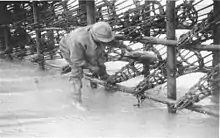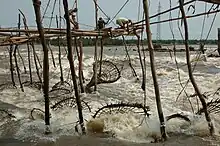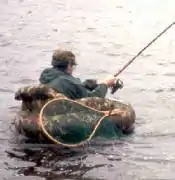Putcher fishing
Putcher fishing is a type of fishing (usually of salmon) which employs multiple putcher baskets, set in a fixed wooden frame, against the tide in a river estuary, notably on the River Severn, in England and South East Wales. Putchers are placed in rows, standing four or five high, in a wooden "rank" set out against the incoming and/or outgoing tides.[1]

George Whittaker collecting salmon from putchers at Goldcliff, circa 1923
Traditionally the putcher was made of hazel rods with withy (willow) plait, both materials being grown locally on the Caldicot and Wentloog Levels. Modern baskets made of steel or aluminium wire were introduced in the 1940s and 1950s.[2][3][4]

Conical baskets on a wooden frame are also used elsewhere; here, Wagenya, to catch the fish thrown downstream by rapids at the Boyoma Falls (aka: Stanley or Kisangani falls) on the Lualaba River, near Kisangani in the Democratic Republic of the Congo. As in the UK, fishing spots are inherited.
See also
References
- "Severn Salmon Boats of the River Severn in Gloucestershire". www.salmonboats.co.uk.
- Goldbold, R.C. and Turner, R.C. (with contributions by Hillam, J., Johnson, S. and O'Sullivan, A.), Medieval Fishtraps in the Severn Estuary, Medieval Archaeology, Vol 38, 1994, pp 19-54. Publisher: Maney. ISSN 0076-6097.
- ""In the old days you could see the horizon!"". Living Levels.
- Jenkins, J. Geraint, Commercial Salmon Fishing in Welsh Rivers. Folk Life - Journal of the Society of Folk Life Studies, Vol 9, 1971
This article is issued from Wikipedia. The text is licensed under Creative Commons - Attribution - Sharealike. Additional terms may apply for the media files.

